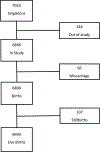Association of late second trimester miscarriages with placental histology and autopsy findings
- PMID: 31670146
- PMCID: PMC6876705
- DOI: 10.1016/j.ejogrb.2019.10.024
Association of late second trimester miscarriages with placental histology and autopsy findings
Abstract
Objectives: To describe the placental histology and autopsy findings in pregnancies where fetal demise occurred before a gestational age of 22 weeks.
Study design: This study was a subset of a larger study where the effect of alcohol exposure during pregnancy on stillbirths was studied. In a prospective cohort, 7,010 singleton pregnancies were followed from the first antenatal visit until infant one year of age visit. Gestational age was assessed by ultrasound, preferably at the first antenatal visit. All pregnancy losses were identified and when the fetuses delivered at or after a gestation of 20 weeks, the mother or parents were approached for consent for autopsy. This study describes the placental pathology and findings at autopsy in losses before 22 weeks gestation (late second trimester miscarriages).
Results: Fourteen cases were identified in which 13 had an autopsy and 12 had a histological examination of the placenta. The most prevalent histological abnormality was placental abruption which was seen in 6 miscarriages, occasionally on its own, or in combination with maternal vascular malperfusion or acute chorioamnionitis. The second most frequent finding was maternal vascular malperfusion, as found in five placentas, alone or in combination with other pathology. The third most frequent pathology was acute chorioamnionitis, found in four placentas, in combination or alone. Other causes were diffuse chronic villitis due to cytomegalovirus infection and early amnion rupture with anhydramnios and cord obstruction.
Conclusions: Causes of fetal demise at the end of the second trimester differ little from causes of stillbirth. There is value in using placental histology in late second trimester miscarriages to try to identify the cause of demise.
Keywords: Autopsy; Late miscarriage; Placental histology; Second trimester miscarriage.
Copyright © 2019 Elsevier B.V. All rights reserved.
Conflict of interest statement
Declaration of Competing Interest
The authors have no conflict of interest to report
Figures
Similar articles
-
Stillbirth and intrauterine fetal death: role of routine histopathological placental findings to determine cause of death.Ultrasound Obstet Gynecol. 2016 Nov;48(5):579-584. doi: 10.1002/uog.16019. Epub 2016 Oct 25. Ultrasound Obstet Gynecol. 2016. PMID: 27781319
-
Relation of placental diagnosis in stillbirth to fetal maceration and gestational age at delivery.J Perinat Med. 2014 Jul;42(4):457-71. doi: 10.1515/jpm-2013-0219. J Perinat Med. 2014. PMID: 24259237
-
When the Fetus Goes Still and the Birth Is Tragic: The Role of the Placenta in Stillbirths.Obstet Gynecol Clin North Am. 2020 Mar;47(1):183-196. doi: 10.1016/j.ogc.2019.10.005. Epub 2019 Dec 18. Obstet Gynecol Clin North Am. 2020. PMID: 32008668 Review.
-
Comparison of the Autopsy and Placental Findings in Second vs Third Trimester Stillbirth.Pediatr Dev Pathol. 2023 Jul-Aug;26(4):345-351. doi: 10.1177/10935266231165854. Epub 2023 Apr 21. Pediatr Dev Pathol. 2023. PMID: 37082921
-
3137 fetuses in 33 years: What we have learned from the Wisconsin stillbirth service program.Am J Med Genet A. 2021 Sep;185(9):2683-2689. doi: 10.1002/ajmg.a.62143. Epub 2021 Feb 25. Am J Med Genet A. 2021. PMID: 33634578 Review.
Cited by
-
The key role of examining the placenta in establishing a probable cause for stillbirth.Placenta. 2022 Nov;129:77-83. doi: 10.1016/j.placenta.2022.10.001. Epub 2022 Oct 13. Placenta. 2022. PMID: 36257090 Free PMC article.
-
The tragedy of smoking, alcohol, and multiple substance use during pregnancy.S Afr Med J. 2022 Aug 2;112(8):526-538. doi: 10.7196/SAMJ.2022.v112i8.16480. S Afr Med J. 2022. PMID: 36214396 Free PMC article.
-
Pregnancy loss and risk of incident CVD within 5 years: Findings from the Women's Health Initiative.Front Cardiovasc Med. 2023 Feb 21;10:1108286. doi: 10.3389/fcvm.2023.1108286. eCollection 2023. Front Cardiovasc Med. 2023. PMID: 36895838 Free PMC article.
-
Role of the vaginal microbiome in miscarriage: exploring the relationship.Front Cell Infect Microbiol. 2023 Sep 13;13:1232825. doi: 10.3389/fcimb.2023.1232825. eCollection 2023. Front Cell Infect Microbiol. 2023. PMID: 37780845 Free PMC article. Review.
-
Strong Association Between Placental Pathology and Second-trimester Miscarriage.Arch Obstet Gynaecol. 2021;2(3):51-56. Arch Obstet Gynaecol. 2021. PMID: 34557867 Free PMC article. No abstract available.
References
-
- MacDorman MF, Gregory ECW. Fetal and perinatal mortality: United States. Natl Vital Stat Rep 2013;2015(64):1–24. - PubMed
-
- Aminu M, Unkels R, Mdegela M, Utz B, Adaji S, van den Broek N. Causes of and factors associated with stillbirth in low- and middle-income countries: a systematic literature review. BJOG 2014;121:141–53. - PubMed
-
- Boklage CE. Survival probability of human conceptions from fertilization to term. Int J Fertil 1990;35:75. - PubMed
-
- Greenwood DC, Alwan N, Boylan S, Cade JE, Charvill J, Chipps KC, et al. Caffeine intake during pregnancy, late miscarriage and stillbirth. Eur J Epidemiol 2010;25:275–80. - PubMed
MeSH terms
Grants and funding
LinkOut - more resources
Full Text Sources
Medical


